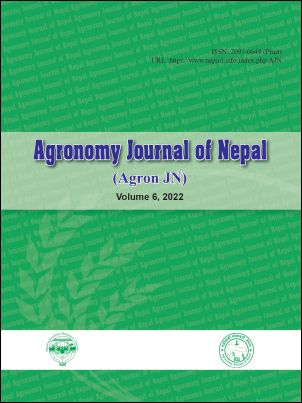Increasing the Productivity of Lentil through Agronomic Interventions in Nepal
DOI:
https://doi.org/10.3126/ajn.v6i1.47941Keywords:
Lentil, seed rate, sowing date, variety, weed managementAbstract
The low productivity of lentil due to adaptation of poor crop management practices is the main problem of the lentil production in western terai region of Nepal. With an objective of selecting appropriate variety, sowing time, sowing method, seeding rate, priming techniques and weed management practice for lentil cultivation four different experiments were conducted at Grain Legumes Research Program, Khajura, Banke in two winter seasons of 2017/18 and 2018/19. The experiment on sowing time was conducted in split-plot design including four lentil varieties and four sowing dates, while the seeding rate experiment was laid out in split-split-plot design with the treatments of two varieties, two sowing methods and four seed rates. Similarly, seed priming and weed management trails were conducted in RCBD with ten treatments. All the experiments were replicated three times. The highest seed yield of lentil was recorded from the early maturing lentil varieties, i.e. PL 4 (934 kg ha–1) and ILL 7979 (864 kg ha–1). Similarly, lentil sowing on October (940 kg ha–1) produced the higher seed yield than sowing on November (682 kg ha–1). Likewise, the highest seed yield of lentil was recorded from the use of seeding rate 60 kg ha–1 (890 kg ha–1), but it was statistically at par with the seeding rates of 40 kg ha–1 (865 kg ha–1) and 50 kg ha–1 (855 kg ha–1). Differently, the seed yield of lentil didn’t differ significantly under line (856 kg ha–1) and broadcasting (847 kg ha–1) methods of sowing. The seed priming with a 250 ppm solution of sodium molybdate (Na2MoO4) produced significantly the highest seed yield (961 kg ha–1) in lentil. Similarly, the highest and statistically similar seed yield of lentil was recorded with the weed management practice of two hand weeding (924 kg ha–1) and the use of Pendimethalin (898 kg ha–1) and Pendimethalin-Quizolofop-ethyl (857 kg ha–1) as a pre-emergence. Thus, the adaptation of appropriate variety, planting time, seeding rate, seed priming technique, sowing method and weed management practices are the major factors of production for getting higher yield of lentil.
Downloads
Downloads
Published
How to Cite
Issue
Section
License
Copyright (c) 2022 Agronomy Society of Nepal (ASoN)

This work is licensed under a Creative Commons Attribution-NonCommercial 4.0 International License.
ASON permits for free use, distribution and reproduction in any medium if the original work is properly cited and not used for commercial purposes.




